In this tactical analysis, we dive into the footballing philosophy of Will Still and his work with RC Lens. As one of the rising stars in football management, Still has crafted a dynamic and disciplined team, making RC Lens a force to be reckoned with in Ligue 1. This article explores his tactical approach, focusing on formations, key player roles, and how his strategies have shaped Lens into a competitive and exciting team. Let’s break down the methods behind Will Still’s success at RC Lens and the tactics that define their play on the pitch.
Build-up
Low Build-up
In the low build-up, Still sets his team up in a 4-2-5 formation. The goalkeeper moves up into the backline to create a back four, allowing the wingers to push higher. The six building players can work together to beat the initial press and the five attackers can cooperate to create goalscoring opportunities.
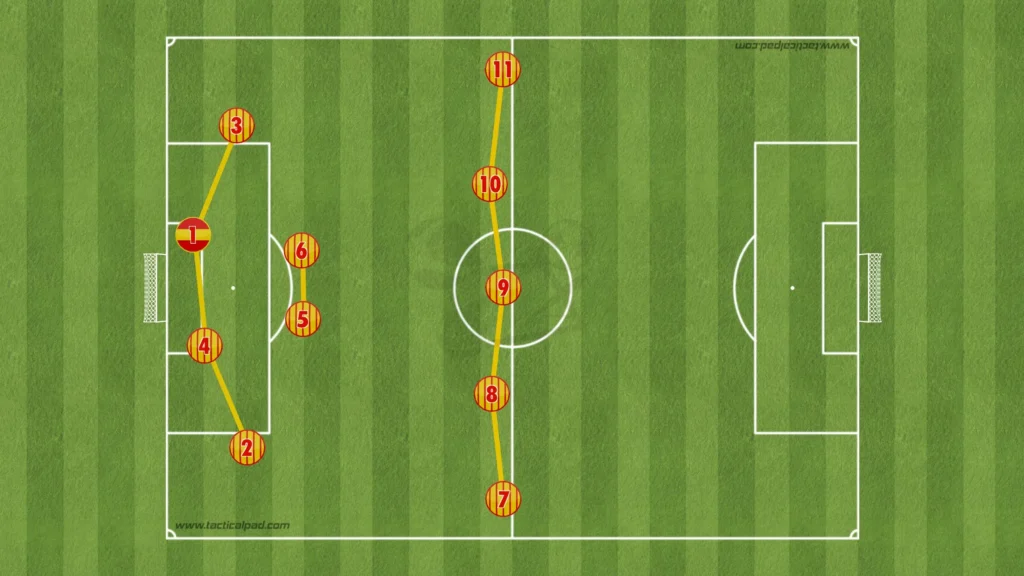
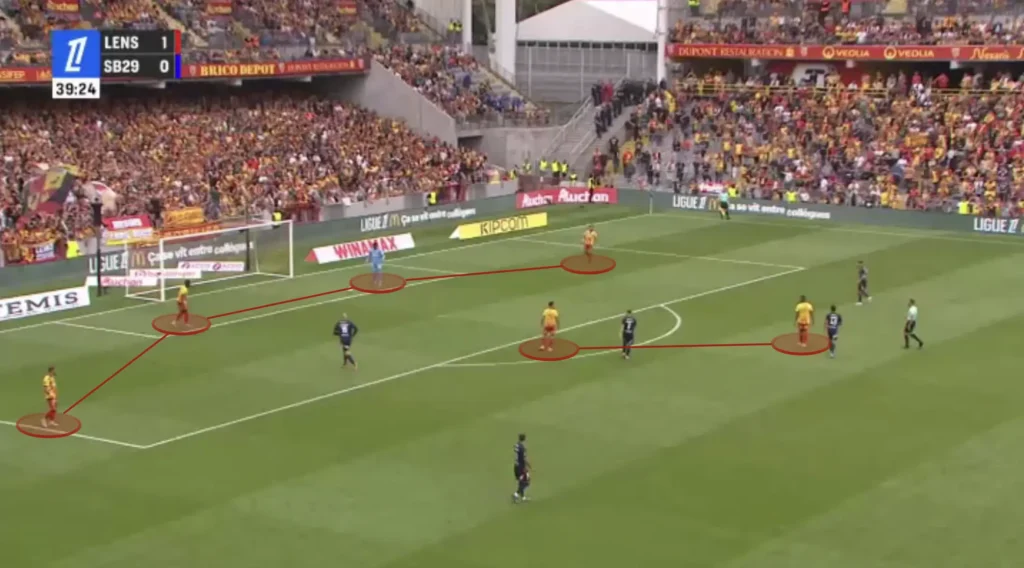
The five attackers start very high, creating a massive space between the opposition midfield and backline for them to drop into. Still mainly wants to beat the press by finding a dropping attacker in this space, who can bounce the ball to a holding midfielder, who then can progress the ball forward.
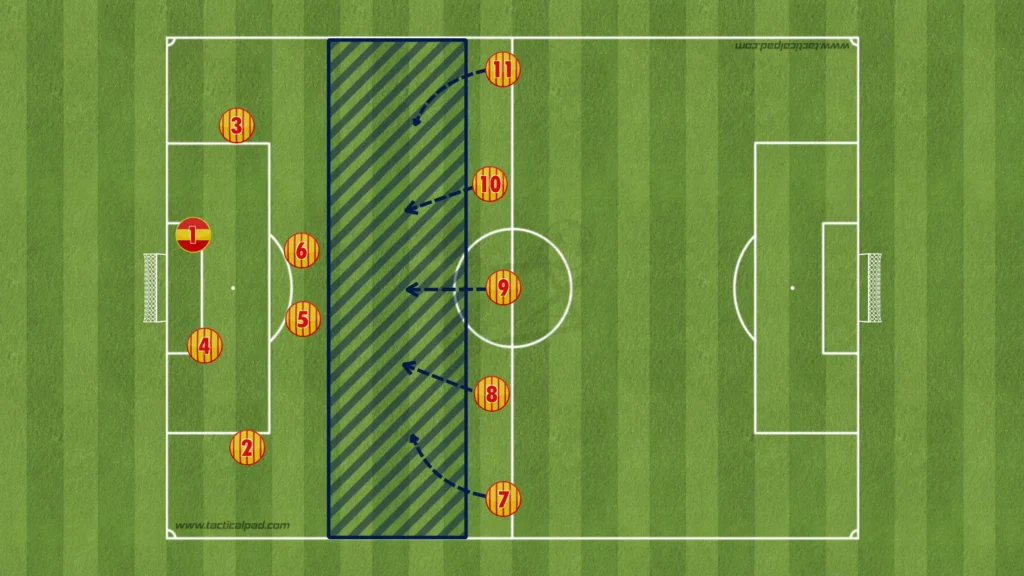
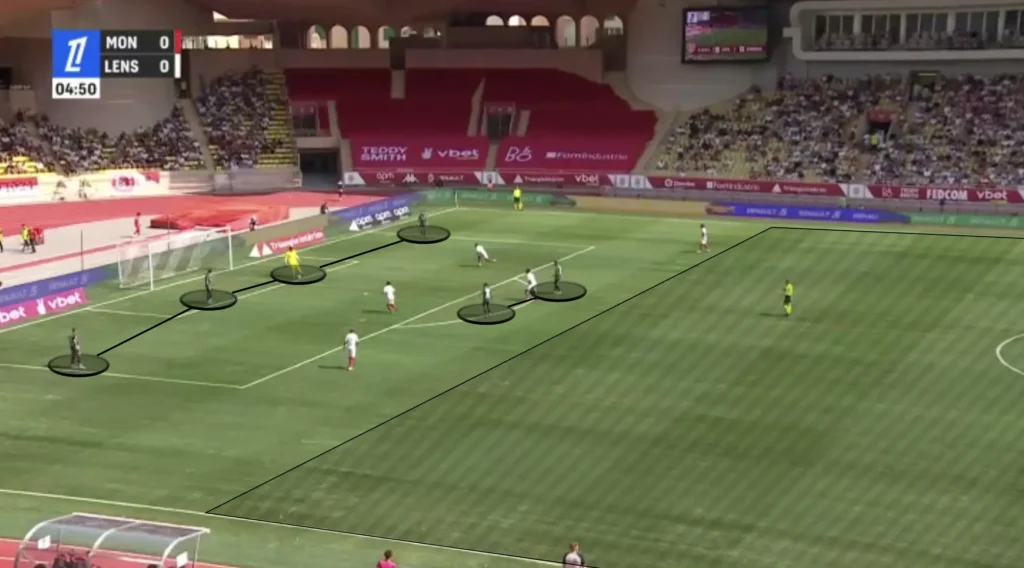
High Build-up
In the high build-up, Still’s RC Lens set up in a 1-3-2-5 formation, the same as in the low build-up without the goalkeeper between the center-backs.
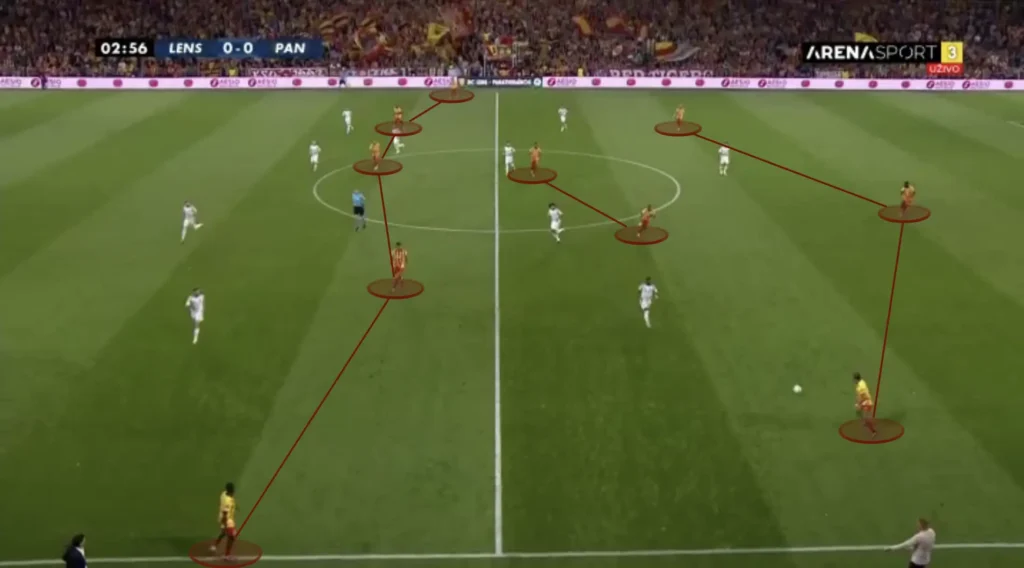
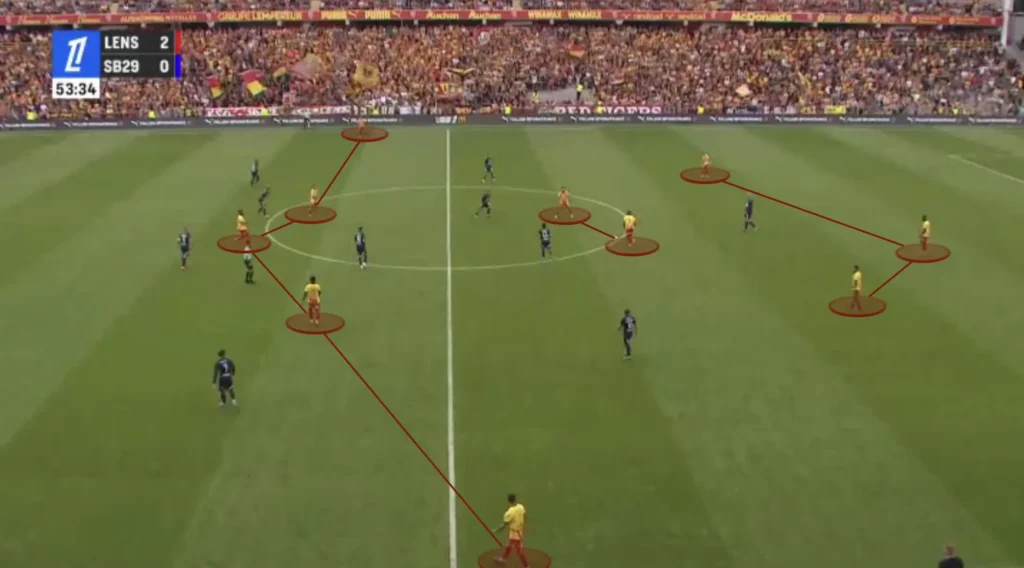
They will usually have only one player on each wing and the rest in the center. Having only two players out wide and the rest in the middle creates more options in the center and less space between the players. Still likes this because he prioritizes playing through the middle. He needs one player out wide to pull the opposition apart while the rest create numerical advantages in the midfield areas. When a team outnumbers the opposition in the midfield, it can more easily retain the ball, exploit spaces, and progress the ball through the center. This advantage forces the opposing team to chase the game, which can lead to defensive errors and create opportunities for breaking down their defense.
Another purpose for keeping many players in the middle is to shorten the distance between them. This shortens the length of the passes, which naturally shortens the time between passes. This means the opposition players will have less time to push up and press, giving the Lens players more time and control.
Sometimes, one of the holding midfielders will move up into a number-ten position, creating a 1-3-1-5-1 formation. This rotation gives Lens more players higher up the pitch and can help break down teams who defend deep in a low-block.
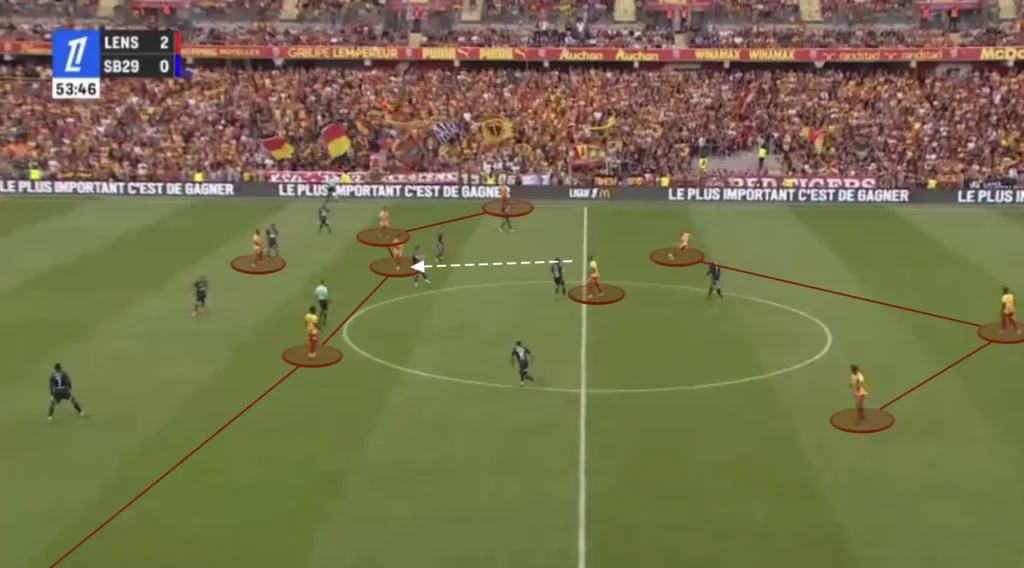
High Backline (Off)
A massive aspect of Will Still’s high possession build-up is to have the defenders high up. This helps in the counterpress because they get closer to the center. Having more players close to the center who can win the ball back makes it difficult for the opposition to do anything when they win possession. Furthermore, the high backline shortens the distance between players, shortening the time and length of the passes and preventing the opposition from pushing up their defense.
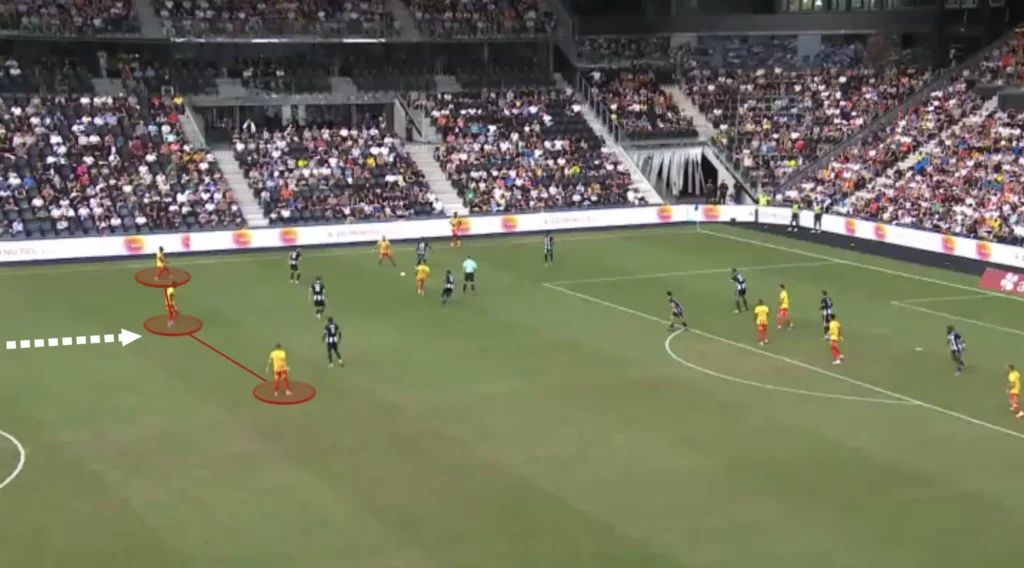
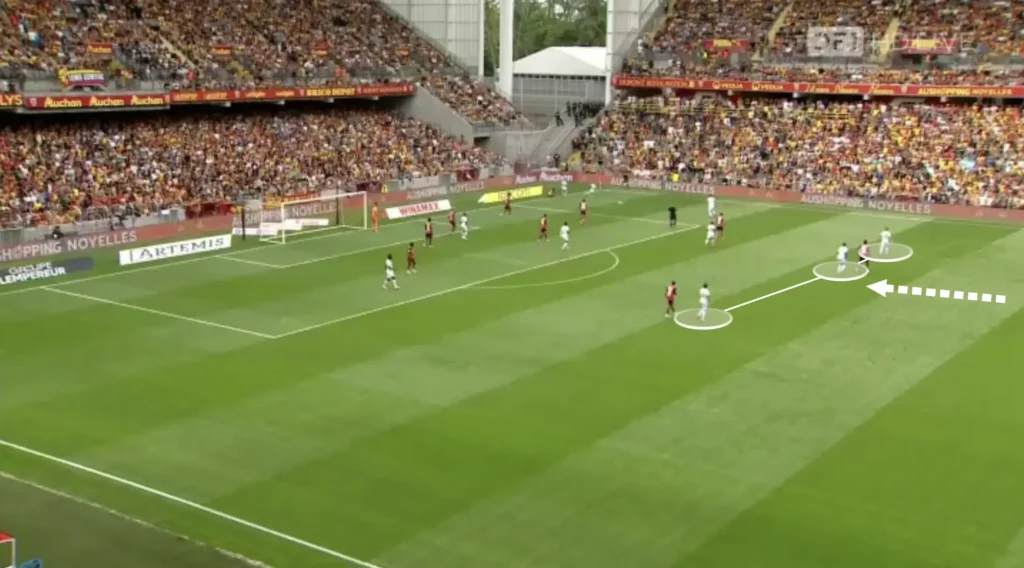
Center-back Movement
An interesting movement that the Lens players often use is to come up with the left center-back behind the opposition’s right-winger. When the ball is on the right side, the left center-back will make the run behind the opposition’s right-winger. This blindside run will often go unnoticed by ball-watching wingers, meaning the center-back will be free in this space. Lens will look for diagonal passes from the holding midfielders to find the center-back in this space, allowing him to progress the ball forward past the opposition midfield.
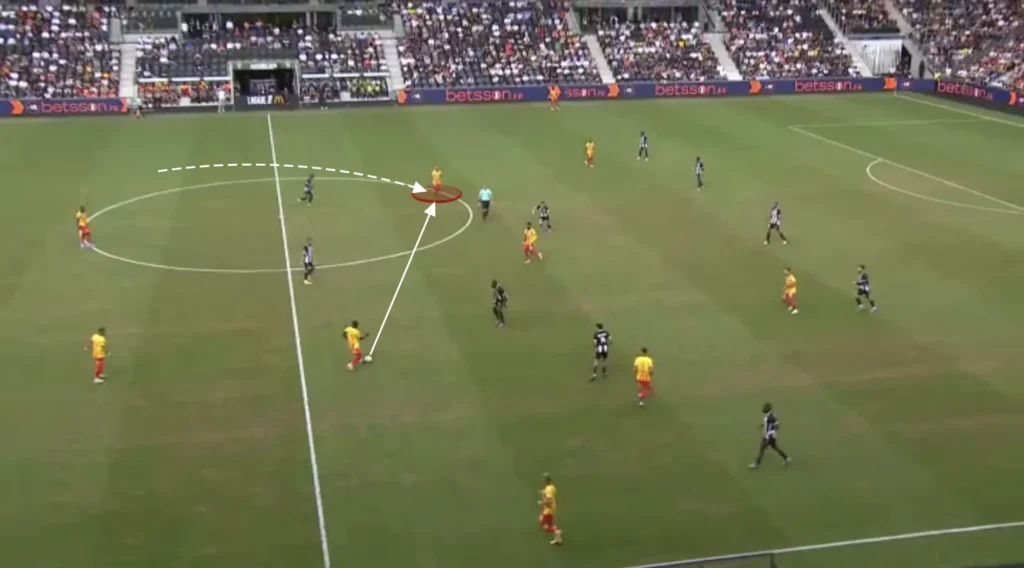
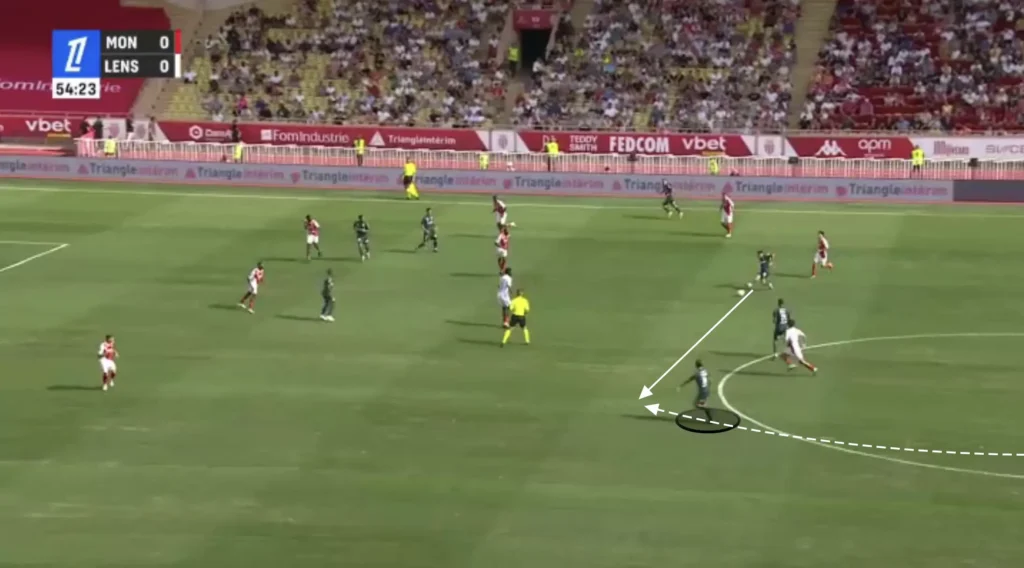
Finding the Pockets
Will Still’s players always try to find the attacking midfielders in the pockets. These “pockets” refer to the spaces between the opposition’s defensive and midfield lines, where the attacking midfielders can receive the ball in more advanced positions.
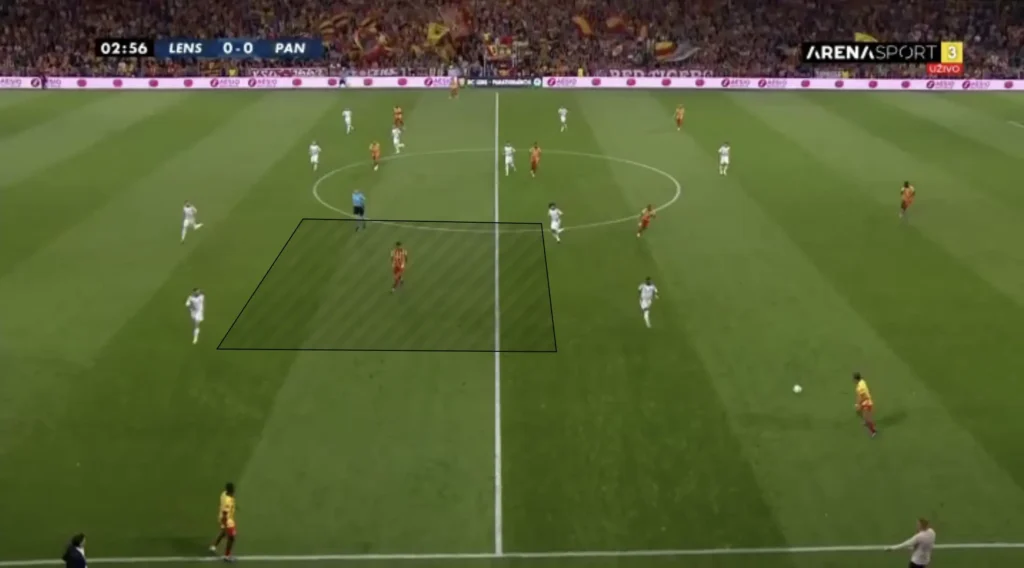
By positioning themselves intelligently in these pockets, the attacking midfielders can turn quickly and face the opposition’s goal, creating opportunities for through balls, driving runs, or direct shots. This positioning forces the opposition to make difficult decisions. If an opposition defender steps up and closes down the attacking midfielder, he potentially leaves space behind. If he stays back, he allows the midfielder time on the ball. The Lens defenders and wingers will look for straight passes, breaking the opposition lines and finding the attacking midfielders who can turn and drive at the defense.
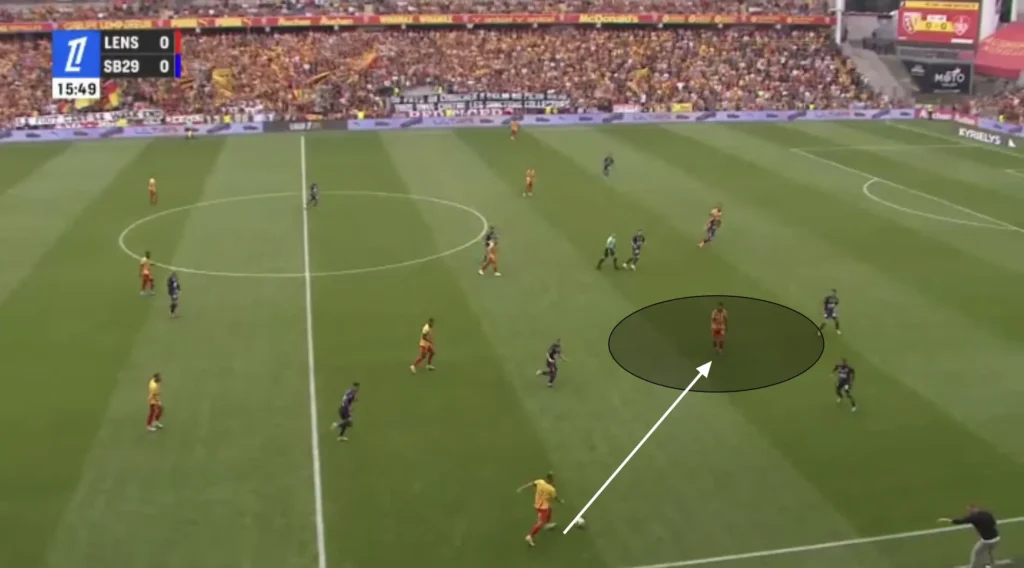
Finding these pockets is crucial for maintaining fluidity in attack and ensuring that the team can progress the ball effectively through the middle of the pitch.
Dropping Outside
When the opposition defends very compactly and does not allow the attacking midfielders to get the ball in the pockets, Lens’ attacking midfielders can drop outside to receive the ball there instead. They will wait for the opposition’s wide midfielders to come into the middle and drop out into the space he left open. The opposition center-backs and central midfielders rarely follow these runs, not wanting to open the space in the center. Additionally, the winger, who is positioned high and wide, will be pinning the opposition fullback, not allowing him to jump on the dropping attacking midfielder. This means that the attacking midfielder can receive the ball, turn, and progress the ball unopposed.
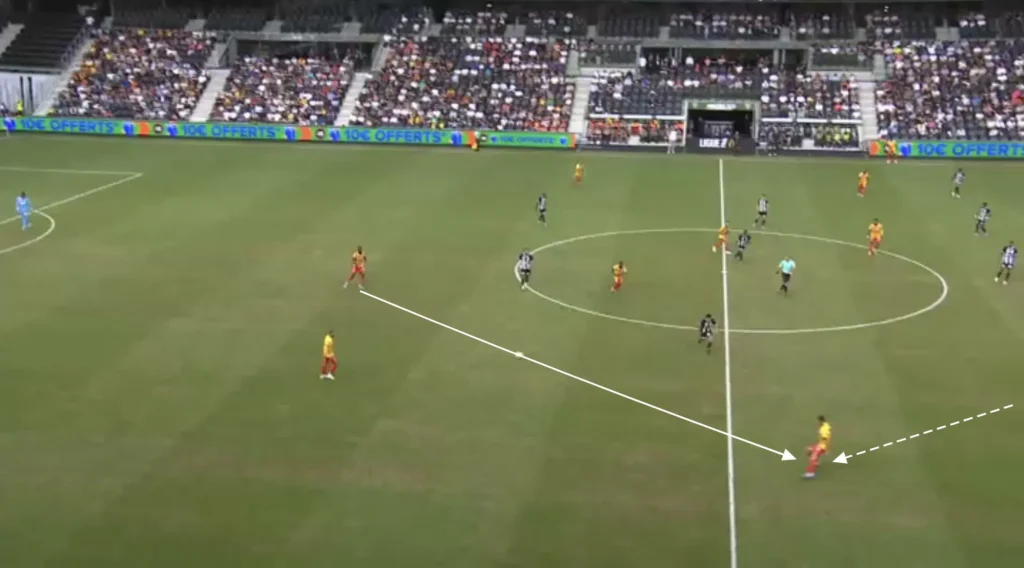
Counter-Movements
Lens will often use counter-movements between the attackers to beat the opposition’s defensive line. When a defender or holding midfielder has the ball, the striker can drop to give a passing option to the ball-holder. This creates a question for the opposition center-back. If he follows the striker, the space behind him opens up, allowing the ball-holder to play a through-ball to an attacking midfielder or winger making a run in behind. However, if he stays in the backline to cover the space, the ball can be played to the striker, who can turn and attack the defense. Here, the center-back follows the striker, allowing the ball to be played in behind to the winger and attacking midfielder.
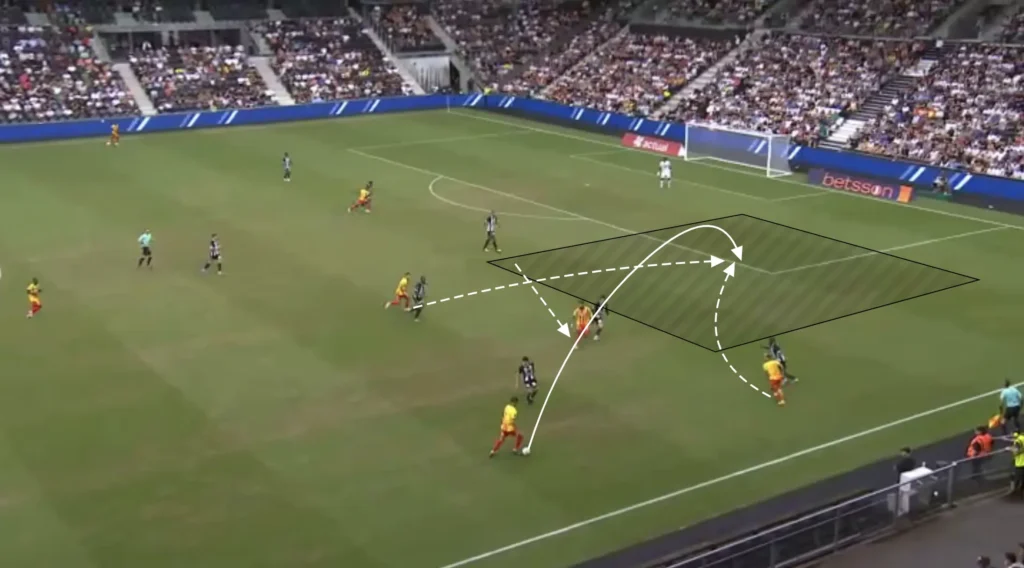
The Lens attackers will use counter-movements like these all the time. When one attacker drops, the other will go in behind, constantly creating questions for the opposition defenders.
Numerical Advantages Against the Opposition’s Defense
Another aspect of Lens’ high build-up is their ability to create numerical advantages against the opposition’s defensive line. Playing with a front five means the forward line naturally becomes numerically superior against a back four, which they are great at taking advantage of.
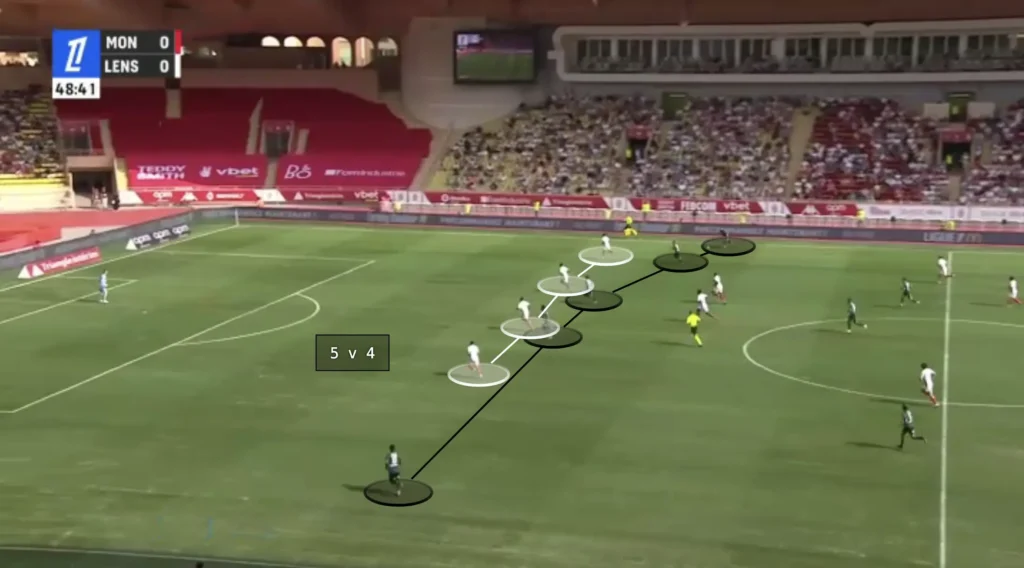
Still’s players mainly exploit this by creating 2v1 situations against the opposition fullback. When the defending team is positioned on one side, the weak-side fullback becomes vulnerable to the long switch of play due to the 1v2 against Lens’ winger and attacking midfielder. The attacking midfielder will make a run in behind, the fullback will follow that run, and the space for the winger out wide will be opened. Still’s team often capitalizes on this by getting the ball to the winger and creating many opportunities from 2v1 situations on the wing and in the half-spaces.
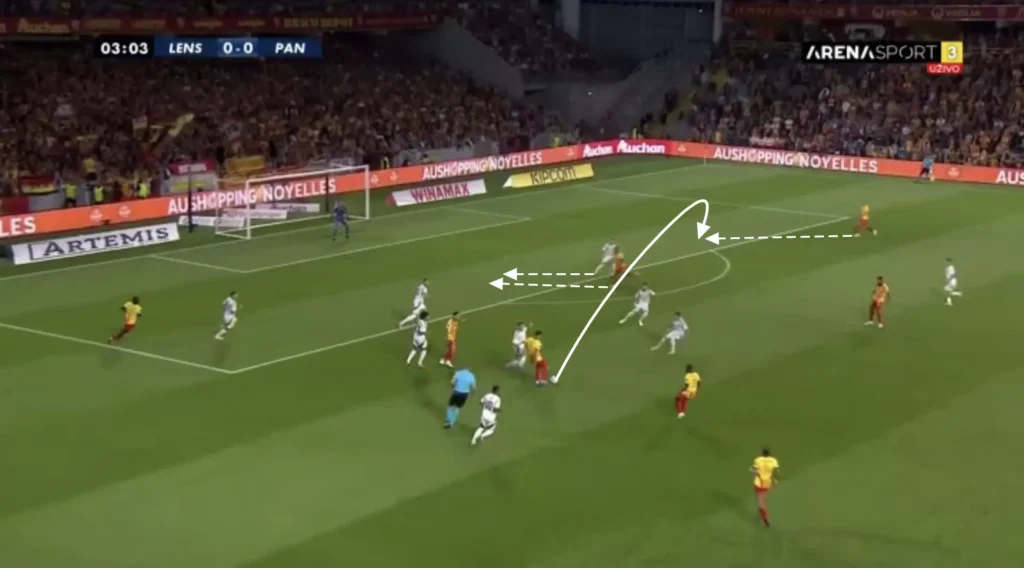
Final Third
Attacking the Half-Space
Will Still’s players usually look to create chances by attacking the space between the opposition center-back and fullback. They primarily do this from the wide areas with underlaps from the attacking midfielders. When the winger receives the ball out wide he will attract the opposition fullback. This opens the space between the fullback and the center-back, which allows the Lens attacking midfielder to make the underlapping run into this space. The ball can be played to the underlapping player, who can cross the ball into the box or attack his defender in a 1v1 situation.
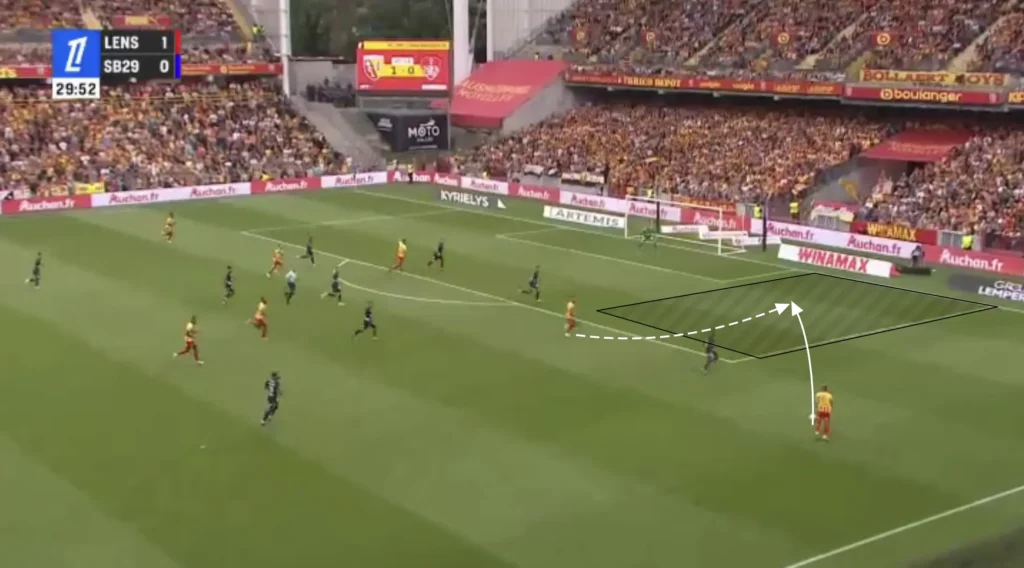
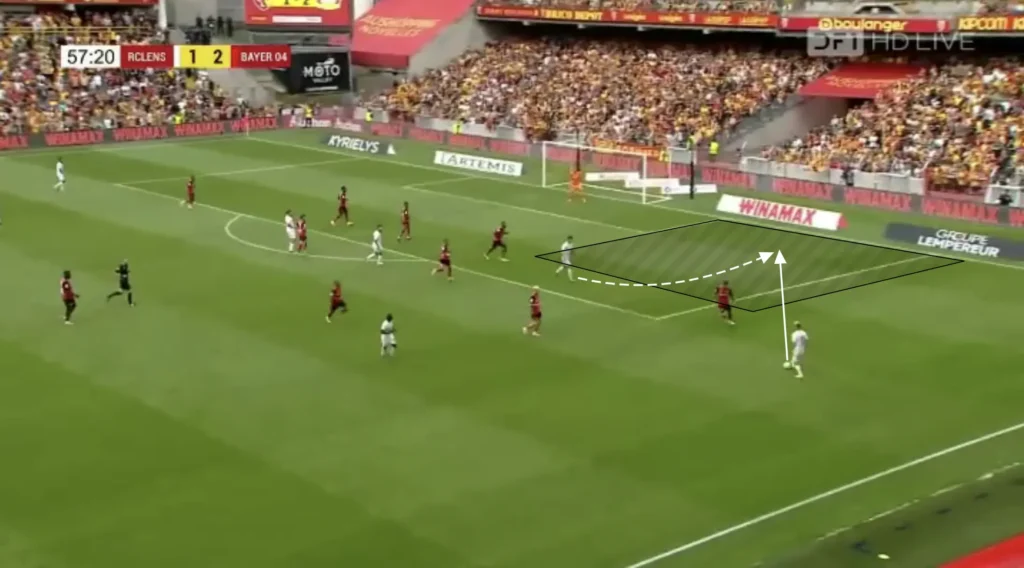
The winger does not have to play the ball to the underlapping player. The run from the attacking midfielder will often drag away an opposition defensive midfielder, which opens the space inside. The winger can take the ball inside and shoot or find a pass to a free player in front of the backline.
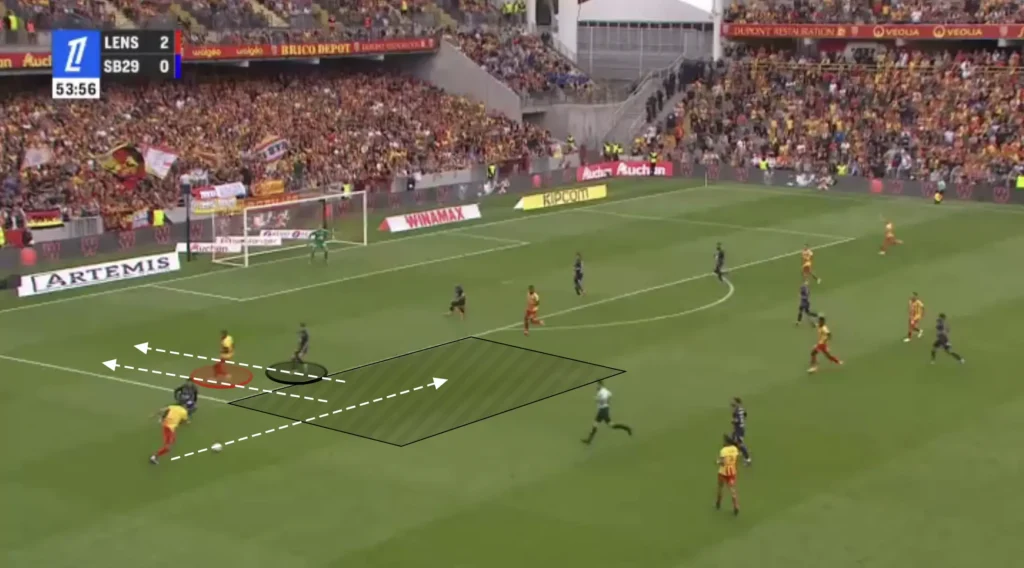
Many Players in the Box
The attacking midfielders and wingers look to make runs into the box when the ball is in the final third, often getting four or five players into these areas to create overloads. The numerical advantages in the box increase the chances of connecting with the cross, as more players present multiple targets for the crosser, making it harder for defenders to mark everyone effectively. Additionally, having multiple players in the box provides options for different types of finishes, whether it’s a header, volley, or a quick tap-in. It also allows for better positioning to react to second balls or rebounds, increasing the likelihood of capitalizing on any defensive errors.
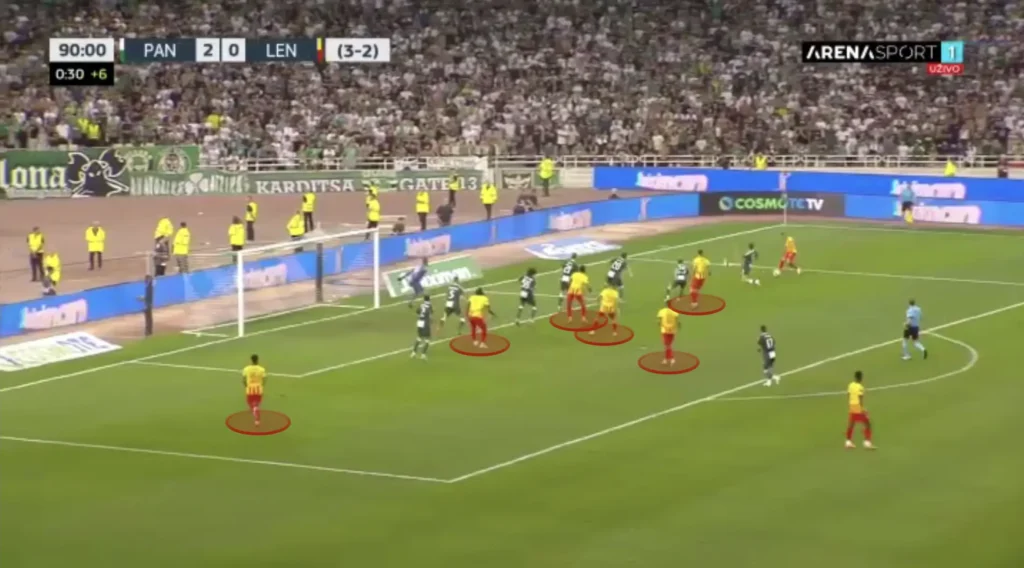
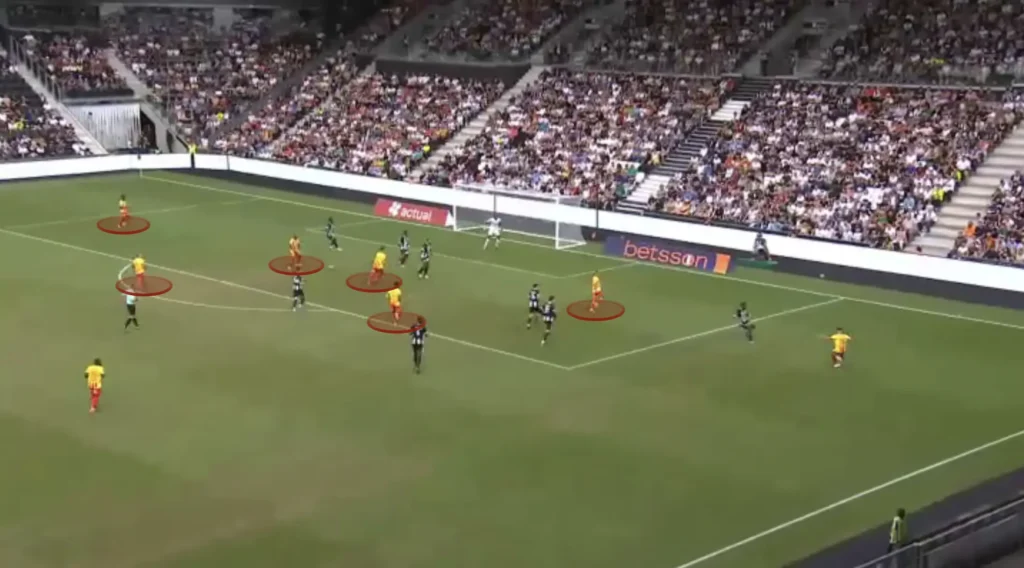
With five attackers, the wingers will score many goals from crosses at the back post. The opposition fullback will often be preoccupied with an attacking midfielder, which leaves massive space at the back post for the winger to attack. The winger can be found directly or indirectly if no one else connects with the cross.

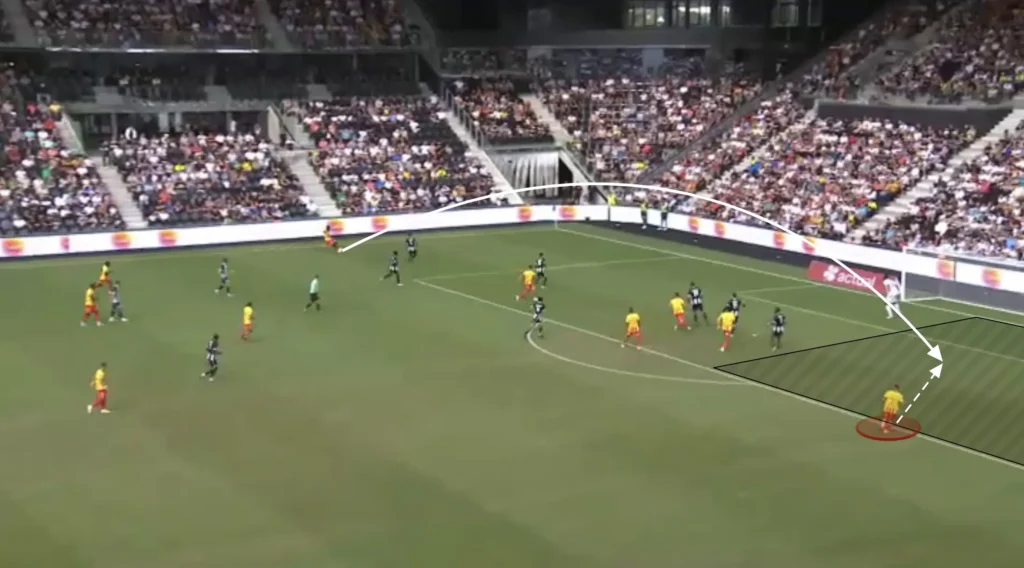
Still also positions many players outside the box, ready for the second balls and cut-backs. Lens will often create crossing opportunities, which pushes down the opposition’s defense and opens the space in front of the opposition’s backline. The holding midfielders can collect any loose balls or be found directly in these spaces with cut-backs, and from there, they can shoot or combine with an attacker to create goalscoring opportunities.
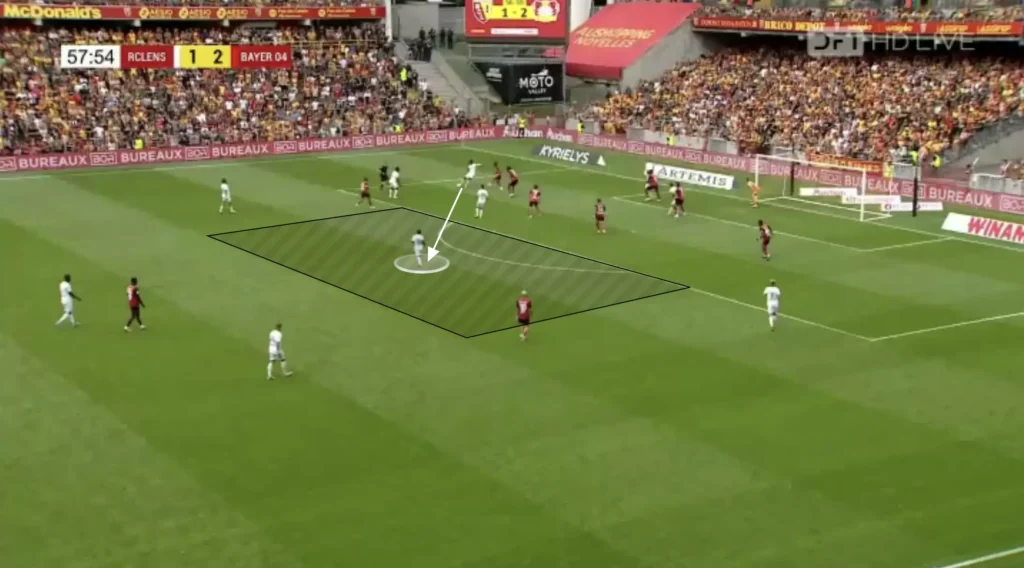
Defending
High Press
Will Still places much value on being aggressive without the ball. This shows in Lens’ high pressure. Still usually wants his team to go man-to-man and intensely press the opposition. Each player is assigned a direct opponent to mark tightly, ensuring no easy passing options are available. This intense pressure forces the opposing team into hurried decisions, often resulting in turnovers in dangerous areas. Lens almost use their high press as an attacking threat, scoring many goals from winning the ball high up the pitch.
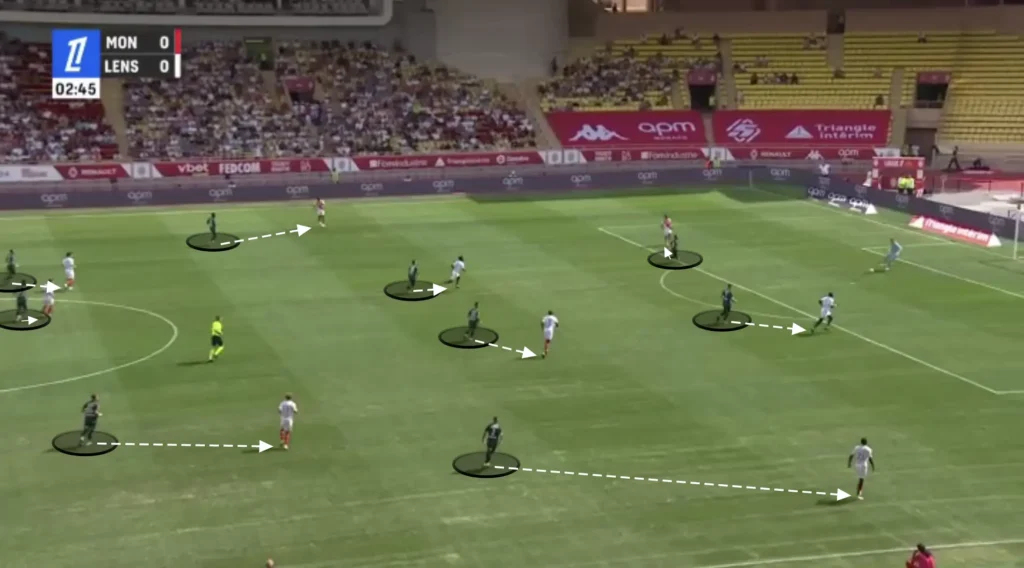
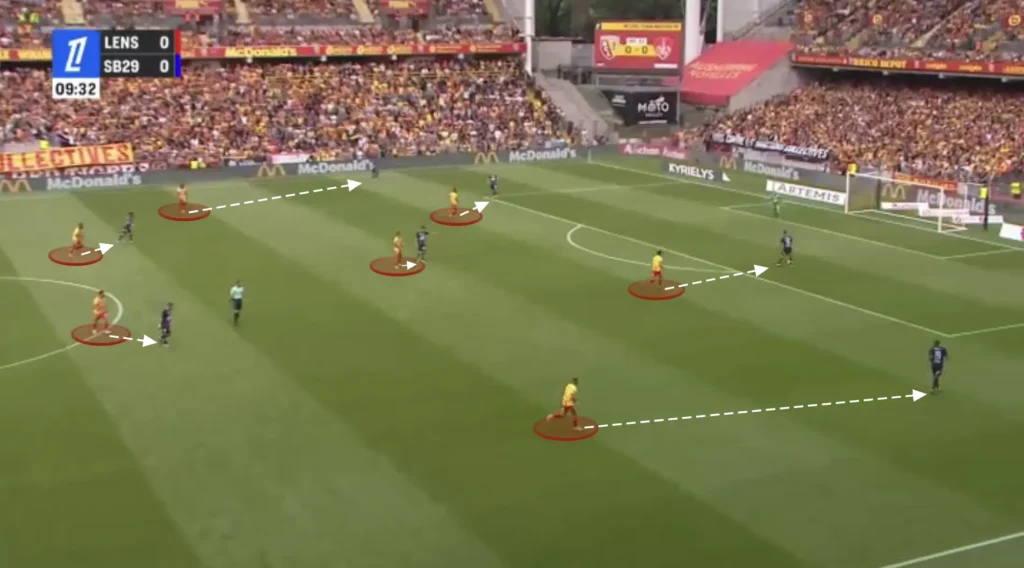
In a man-to-man system, it becomes crucial that the players know when to mark the opponent they are responsible for and when not to. If an opponent, for example, is very far from the ball, the Lens player marking him does not need to be as close to him. He can instead come in and help create numerical superiorities in the center, decreasing the risk of dangerous 1v1 situations. A rule of thumb for the players could be that the closer you are to the ball, the closer you need to be to your opponent. The further away you are from the ball, the further away you can be from your opponent.
Low Press
Still’s RC Lens uses a 1-5-2-3 formation in the low press. They look to set up in a mid-block, always trying to close the center and force the opposition out wide. Defending in a 1-5-2-3 formation is centered around maintaining a compact forward line that forces the opposition to progress the ball on the flanks. Still wants his team to stay compact without dropping too low, preferably closing the space between the midfield and backline.
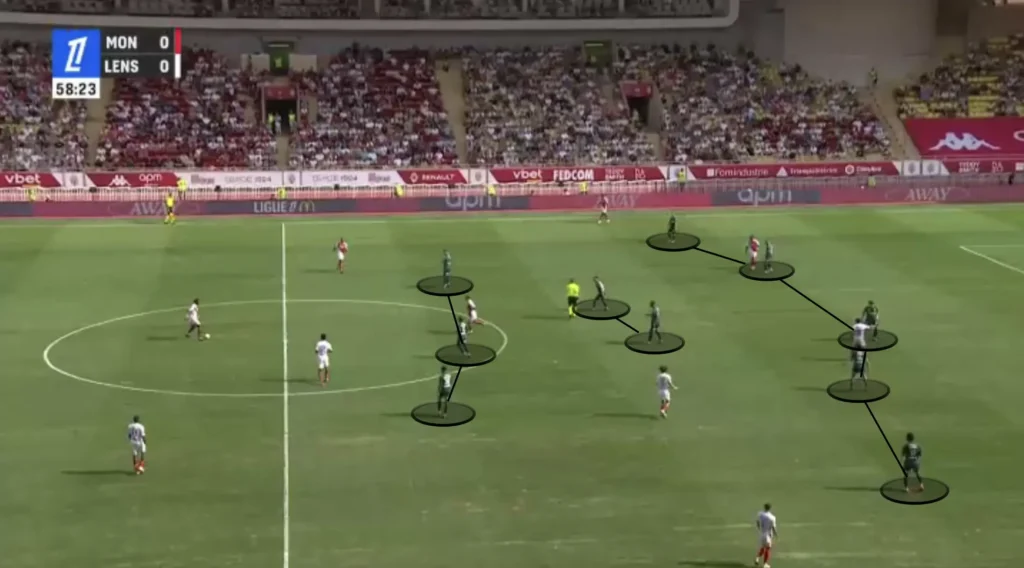
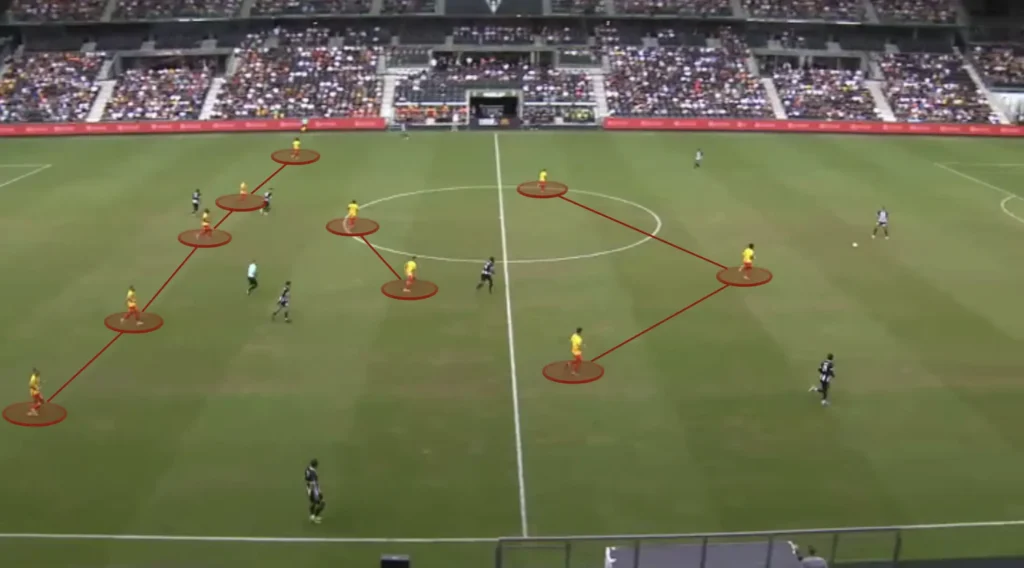
In Still’s defensive system, the wingers are the ones who push up to press the opposition center-backs, while the striker drops off to cover the opposition midfielders. When the wingers press the center-backs, they close the passing lanes to the opposition fullbacks. This forces the opposition center-backs into the middle, where Still wants to win the ball with the striker, who blocks off all passes to the opposition midfielders.
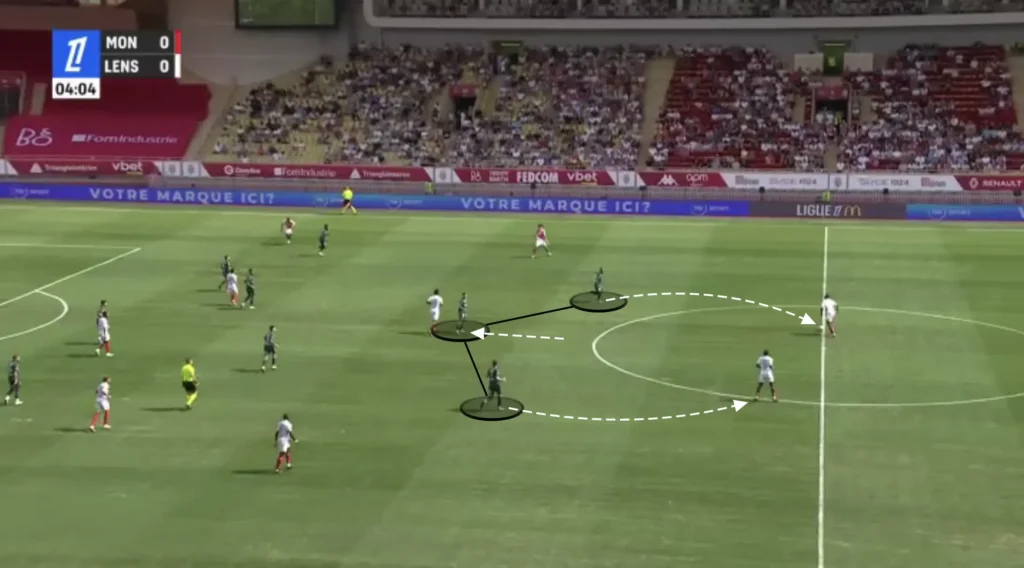
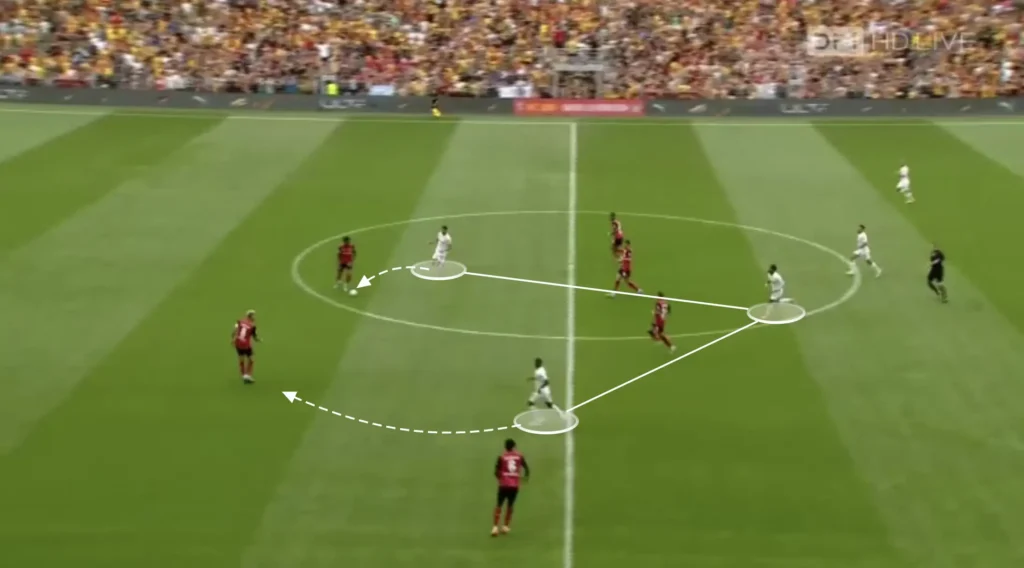
High Backline (Def)
One tool that helps to be compact is to play with a high backline, making the space to the midfield line as small as possible. Still’s players do this and usually try to keep the highest line they can without leaving the space behind them too open. Defending with a high backline involves positioning the defensive line closer to the midfield, rather than near the goalkeeper. This tactic compresses the space available for the opposing team to operate, disrupting their build-up play and increasing the chances of winning the ball back quickly.
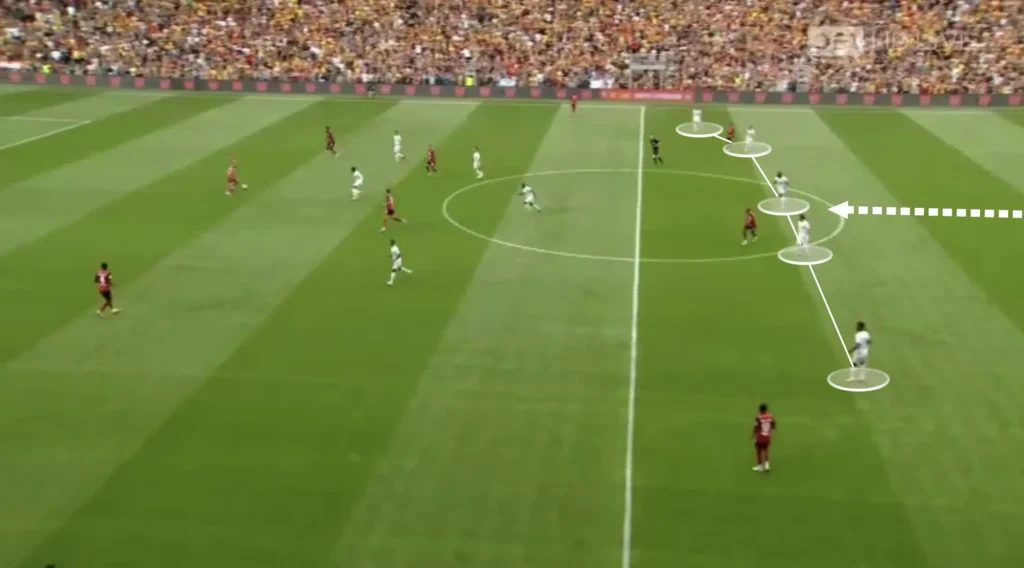
A high backline also allows defenders to support the midfield more effectively, creating numerical superiority in central areas and facilitating quicker transitions from defense to attack. However, it requires defenders with good pace and positional awareness to deal with long balls and prevent opposing attackers from exploiting the space behind. This approach demands constant communication and coordination among the backline to maintain a cohesive and effective defensive structure.
Everyone must be in the same line when defending with a high backline to maintain an effective offside trap, ensure cohesive coverage, and reduce gaps that attackers can exploit. A well-aligned defensive line makes it easier to catch opposing forwards offside, preventing them from receiving the ball in dangerous positions. Additionally, this alignment helps defenders support each other, allowing for quick transitions and coordinated movements to tackle, intercept, and clear the ball.
Aggressive Center-backs
A notable aspect of Lens’ low press is their aggressive wide center-backs. The wide center-backs are never afraid to push up on an opposition midfielder to stop them from turning and driving with the ball. This forces the opposition back while giving the Lens midfielders and attackers more freedom to push up and press when defending. The problem with pushing up a center-back is that big spaces get created between the defenders. Still’s players are, however, great at solving this. The backline will quickly become a compact back four, with the defenders coming across to close the space that the pushing center-back opened.
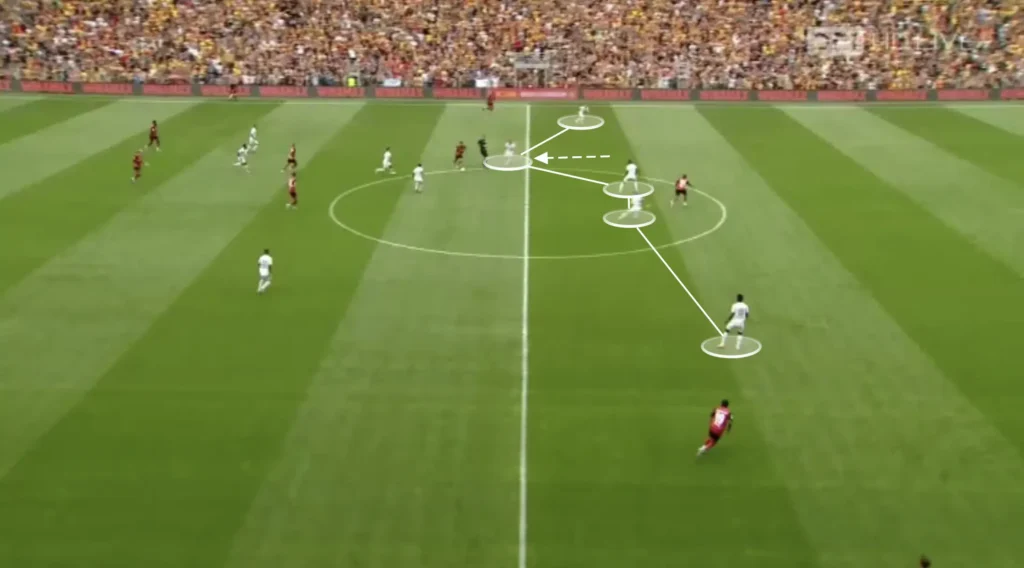
Squeezing the Pitch
Additionally, Will Still always wants his team to squeeze the pitch when defending. This means constantly pushing the team up as much as possible. Every time the opponent plays a slow, sideways pass or a back pass, Lens’ first line of pressure pushes up, with the rest of the team following to stay compact. When the next pass comes, they push up even more, forcing the opponent back even more. They do this because it pushes the opponent further away from the Lens goal, making it harder to create chances.
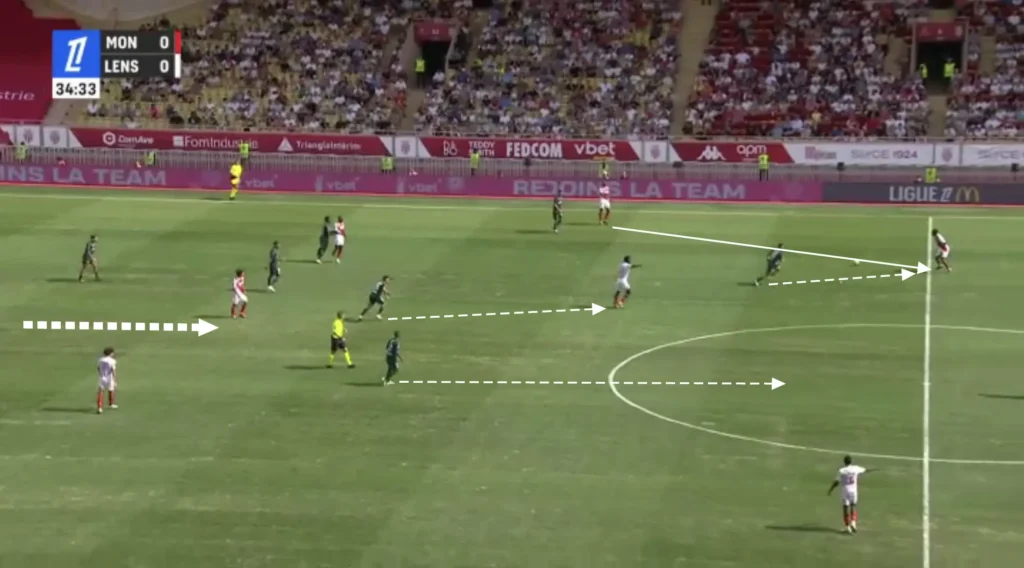
Transitions
Defensive Transitions
Positioning many players centrally, creating a numerical advantage in the midfield, creates good conditions in defensive transitions. Many players close to the ball after losing possession means that many players can work towards regaining possession. Still’s players are also very aggressive in the first seconds after losing the ball. The four or five players closest will immediately jump on the opposition player with the ball and close the distance to cut off any passing lanes. This approach disrupts the opponent’s transition from defense to attack, forcing errors and creating opportunities to regain control in dangerous areas.
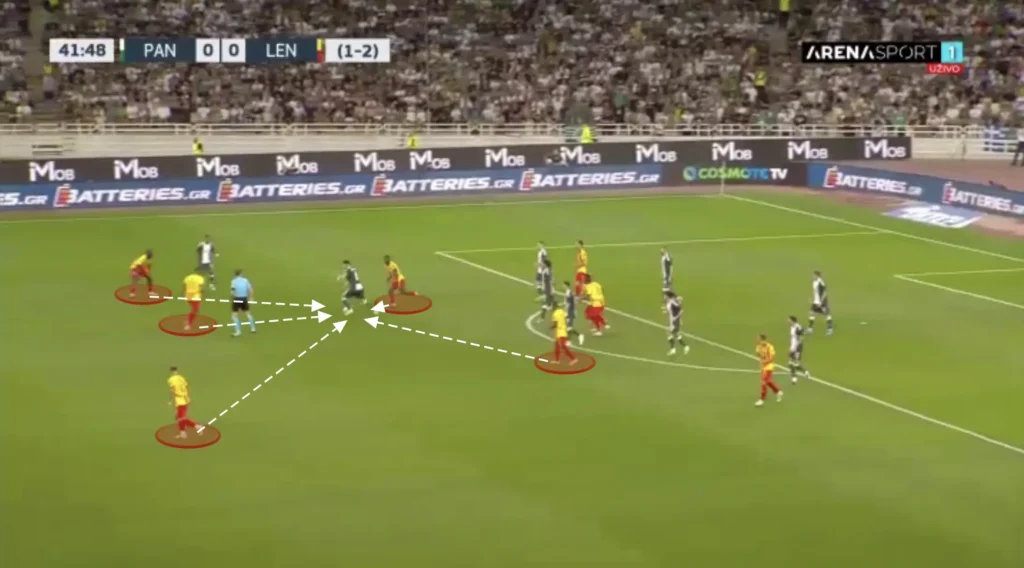
Counterpressing like this keeps Lens on the front foot, allowing them to dominate possession and create more scoring opportunities. However, it requires exceptional fitness, tactical discipline, and teamwork, making it a hallmark of Will Still’s dynamic and aggressive style of play.
Offensive Transitions
Will Still also wants his team to counterattack in their offensive transitions. When winning the ball back, the team transitions quickly from defense to attack, utilizing the speed and movement of their forward players. Still emphasizes vertical passes to exploit spaces left by the opposition, often targeting wide areas or gaps between defenders. Lens’ counterattacks are well-organized, with players making intelligent off-the-ball runs to create overloads and support the ball carrier. This quick, direct style catches opponents off guard, making Lens a dangerous team on the break. Additionally, Lens’ aggressiveness means they have many players high up when defending, which enables them to incorporate more players into the counterattacks.
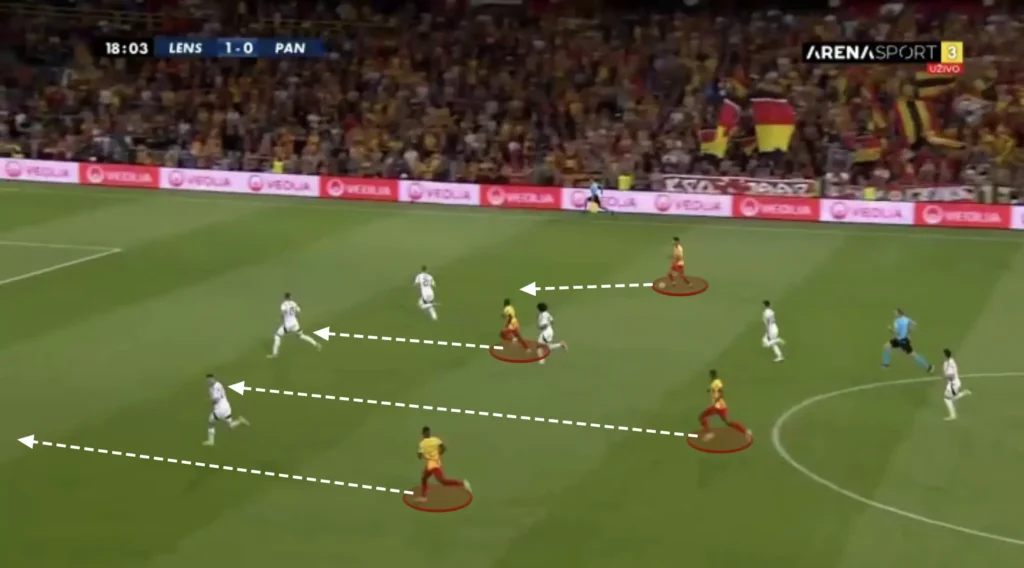
Final Thoughts
In conclusion, Will Still’s tactical approach at RC Lens demonstrates a deep understanding of modern football, blending defensive organization with fluid, attacking play. His ability to adapt formations and implement a high-pressing, possession-based style has made Lens a formidable side. The team’s discipline, combined with their creativity in the final third, highlights Still’s strategic mind and growing influence as a manager.
As RC Lens continues to develop under his leadership, it’s clear that Will Still’s tactical intelligence is driving the team’s success, making them a force to be reckoned with in Ligue 1.
